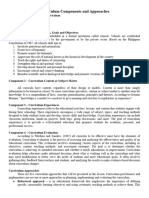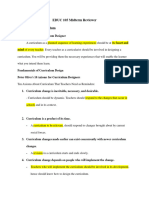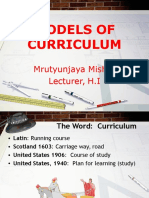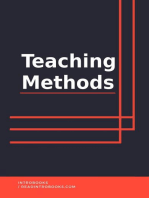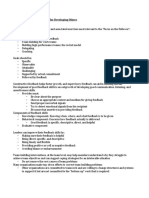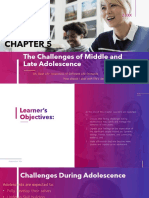0 ratings0% found this document useful (0 votes)
35 viewsCurriculum Approaches
Curriculum Approaches
Uploaded by
Moises Embalzado Bacus Jr.The document discusses several approaches and models for developing curriculum. It describes the technical-scientific and nontechnical-nonscientific approaches, then lists some common curriculum approaches like behavioral, academic, managerial, and humanistic. It also outlines several influential curriculum design models, including Tyler's 4 basic principles model, Taba's grassroots model, Hunkins' decision-making model, Wiggins and McTighe's backward design model, the deliberation model, and the concerns-based adoption model. The innovation configuration model supports the concerns-based adoption model by focusing on addressing concerns about curriculum innovations.
Copyright:
© All Rights Reserved
Available Formats
Download as PDF, TXT or read online from Scribd
Curriculum Approaches
Curriculum Approaches
Uploaded by
Moises Embalzado Bacus Jr.0 ratings0% found this document useful (0 votes)
35 views14 pagesThe document discusses several approaches and models for developing curriculum. It describes the technical-scientific and nontechnical-nonscientific approaches, then lists some common curriculum approaches like behavioral, academic, managerial, and humanistic. It also outlines several influential curriculum design models, including Tyler's 4 basic principles model, Taba's grassroots model, Hunkins' decision-making model, Wiggins and McTighe's backward design model, the deliberation model, and the concerns-based adoption model. The innovation configuration model supports the concerns-based adoption model by focusing on addressing concerns about curriculum innovations.
Copyright
© © All Rights Reserved
Available Formats
PDF, TXT or read online from Scribd
Share this document
Did you find this document useful?
Is this content inappropriate?
The document discusses several approaches and models for developing curriculum. It describes the technical-scientific and nontechnical-nonscientific approaches, then lists some common curriculum approaches like behavioral, academic, managerial, and humanistic. It also outlines several influential curriculum design models, including Tyler's 4 basic principles model, Taba's grassroots model, Hunkins' decision-making model, Wiggins and McTighe's backward design model, the deliberation model, and the concerns-based adoption model. The innovation configuration model supports the concerns-based adoption model by focusing on addressing concerns about curriculum innovations.
Copyright:
© All Rights Reserved
Available Formats
Download as PDF, TXT or read online from Scribd
Download as pdf or txt
0 ratings0% found this document useful (0 votes)
35 views14 pagesCurriculum Approaches
Curriculum Approaches
Uploaded by
Moises Embalzado Bacus Jr.The document discusses several approaches and models for developing curriculum. It describes the technical-scientific and nontechnical-nonscientific approaches, then lists some common curriculum approaches like behavioral, academic, managerial, and humanistic. It also outlines several influential curriculum design models, including Tyler's 4 basic principles model, Taba's grassroots model, Hunkins' decision-making model, Wiggins and McTighe's backward design model, the deliberation model, and the concerns-based adoption model. The innovation configuration model supports the concerns-based adoption model by focusing on addressing concerns about curriculum innovations.
Copyright:
© All Rights Reserved
Available Formats
Download as PDF, TXT or read online from Scribd
Download as pdf or txt
You are on page 1of 14
Curriculum Approaches
Curriculum is best understood when one is grounded with the
approaches by which this is developed. Ornstein, A and Hunkins, F.
(2016) elaborated the idea of holistic position encompassing curriculum
foundations, domains theory and practice.
“An approach expresses a viewpoint about curriculum’s development
and design; the role of the learner, teacher, and curriculum specialist in
planning the curriculum, the curriculum goals, and the important issues
that must be examined.”
To Ornstein & Hunkins (2016), curriculum approaches can be viewed
from a technical-scientific perspective or from
nontechnical-nonscientific viewpoint. The technical-scientific coincide
with the traditional theories and models of education and reflect
established, formal methods of learning. Key characteristics of this
approach are a) curriculum as plan or blueprint, b) definable process, c)
means-end paradigm, d) subject-centered, e) emphasis on efficiency,
and f) criticized as too linear. Conversely, the
nontechnical-nonscientific approach, which tends to challenge the
established, evolved as part of avant-garde and experimental
philosophies and politics. This approach is characterized by a)personal,
subjective, evolving and aesthetic nature of curriculum, b) holistic
learning, and c) learner-centeredness.
Curriculum Approaches
Behavioral Approach Academic Approach
Managerial Approach Humanistic Approach
Systems Approach Postmodern Approach
Curriculum Design Models
By adopting a model, curriculum designers are guided to consider
multiple variables such as social and political realities and permit
choices to develop students’ knowledge, skills and attitudes. How is a
curriculum developed? What are the steps and principles that are
involved in curriculum development? Here are the curriculum models
which have been instrumental in shaping today’s curriculum.
Ralph Ralph Tyler’s Model : Four Basic Principles
Tyler combined behaviorism with progressivism by putting emphasis
on the attainment of the learning objectives while taking into account
the learners’ needs. His principles are expressed in terms of questions.
• What educational purposes should the school seek to attain?
• How can learning experiences be selected that are likely to be useful
in attaining these objectives?
• How can learning experiences be organized for effective instruction?
• How can the effectiveness of learning experiences be evaluated?
Hilda Taba’s Model : Grassroots Rationale/Linear Model
Taba’s model can be seen as an extension of Tyler’s. Expressed in 7 stages, the development of a curriculum commence with an
identification and understanding of the learner’s needs. It begins where the learners are.
Stage 1. Diagnosing of Needs
The students’ needs are identified. Curriculum planning is anchored on the nature and developmental needs of the students.
Stage 2.Formulating the Objectives
Teachers specify the set of objectives, the units of work to be accomplished by the students within the allotted time.
Stage 3. Selecting the Content
With the objectives, the teacher decides the scope of the curriculum. This include the topics by which the necessary knowledge, skills
and attitudes are developed.
Stage 4. Organizing the content
The teachers sequence the content taking into consideration the developmental needs, academic achievement, abilities and interests of
the students.
Stage 5. Selecting the learning experiences
Content must be presented to students and students must be engaged in the content.
Stage 6. Organization of learning experiences
Learning activities must be organized. The teacher needs to keep in mind the particular students whom he/she will be teaching.
Stage 7.Evaluating what has been accomplished
Curriculum planners must determine just what objectives have been accomplished.
Hunkins’ Decision-making Model
In this model, Hunkins emphasized that curriculum is dynamic and that
planners must not only consider diagnosis as the base and the evaluation as
the summit of the process. This model has also 7 steps which are as follows:
• curriculum conceptualization and legitimization
• curriculum diagnosis
• curriculum development content selection
• curriculum development experience selection
• curriculum implementation
• curriculum evaluation
• curriculum maintenance
Wiggins and McTighe Backward Design
Model
Instructors typically approach course design in a “forward design”
manner, meaning they consider the learning activities (how to teach the
content), develop assessments around their learning activities, then attempt
to draw connections to the learning goals of the course. In contrast, the
backward design approach has instructors consider the learning goals of the
course first. These learning goals embody the knowledge and skills
instructors want their students to have learned when they leave the course.
Once the learning goals have been established, the second stage involves
consideration of assessment. The backward design framework suggests that
instructors should consider these overarching learning goals and how
students will be assessed prior to consideration of how to teach the content.
For this reason, backward design is considered a much more intentional
approach to course design than traditional methods of design.
The Deliberation Model
True to its name, this model acknowledges the need to involve the stakeholders in
curriculum planning. The comments and positions obtained during deliberations are
important inputs in designing the curriculum. The steps consist of:
• Public Sharing. An educational group must come together and discuss what
• needs to be accomplished.
• Highlighting Agreement and Disagreements. The education group must highlight what
they have in common and also what they differ in opinion.
• Explaining Positions. The members of the group will take the information from the
previous phases and make clear the various positions.
• Highlighting Changes in Position. Educators make known any change in position.
• Negotiating Points of Agreement. This part engages the participants in searching for
solutions.
• Adopting a Decision. It is in this part that the individuals working together achieve
consensus.
Concerns-based Adoption Model (CAM)
In this model, the core are the various concerns that are projected
in each of the elements of curriculum designing. Designers and
implementers of curriculum have to be perceptive to address the
relevant arguments that affect the quality of teaching and learning.
These concerns consist of the awareness of innovation, awareness of
information level, concern for self, concern for teaching, and concern
for students.
Innovation Configuration (IC)
The IC model supports the CAM as it centers on the expressed
concerns: the awareness of innovation. The steps are as follows:
• Ask the developer about intended components and emphases
• Interview and observe a small number of users
• Refine interview questions, interview a large number of users
• Construct an IC checklist and use it with a number of users
• Analyze the checklist data to identify dominant configurations
• Use the data to provide appropriate development or in-service
activities
Thank you for listening!
You might also like
- L6M1 Strategic Ethical Leadership V 3.0 CDDocument89 pagesL6M1 Strategic Ethical Leadership V 3.0 CDEmmannuelNo ratings yet
- Models of CurriculumDocument5 pagesModels of CurriculumMarianne Parohinog75% (4)
- Models of Curriculum Development PPT 25 NOVDocument44 pagesModels of Curriculum Development PPT 25 NOVPriyanka SheoranNo ratings yet
- Strategies For Curriculum ChangeDocument10 pagesStrategies For Curriculum Changesaira tariq100% (8)
- 2008 Putin StudyDocument19 pages2008 Putin StudyUSA TODAY67% (3)
- Roger Ballen 1Document36 pagesRoger Ballen 1lukamm100% (2)
- BHC RecruitingDocument3 pagesBHC RecruitingFaheem Easa Abdulla MoosaNo ratings yet
- Knowledge and Curriculum Development Unit IIDocument11 pagesKnowledge and Curriculum Development Unit IITshering DomaNo ratings yet
- Lesson 1.4: Processes and Models of Curriculum DevelopmentDocument7 pagesLesson 1.4: Processes and Models of Curriculum DevelopmentEdsel Buletin100% (1)
- POLON - Asynchronous Task No. 3 (Advanced Curriculum Planning, Evaluation and Development)Document11 pagesPOLON - Asynchronous Task No. 3 (Advanced Curriculum Planning, Evaluation and Development)Pey PolonNo ratings yet
- Models of CurriculumDocument15 pagesModels of CurriculumHemantNo ratings yet
- Ped 7. ReviewerDocument7 pagesPed 7. ReviewerJOANA BELEN CA�ETE JABONETANo ratings yet
- EDCI 211 Models of Curriculum DevelopmentDocument16 pagesEDCI 211 Models of Curriculum DevelopmentLemaragiti SapukiNo ratings yet
- CD Assignment NewDocument6 pagesCD Assignment NewumaizatawheedNo ratings yet
- Curriculum Components and ApproachesDocument6 pagesCurriculum Components and ApproachesRico BasilioNo ratings yet
- Curriculum Development: Module 7: Fundamental of Curriculum DesigningDocument22 pagesCurriculum Development: Module 7: Fundamental of Curriculum DesigningMark Angelo De GraciaNo ratings yet
- Understand Theories Principles and MoDocument9 pagesUnderstand Theories Principles and MoWahyu Adi PurnomoNo ratings yet
- HandoutsDocument12 pagesHandoutsArman Merlin De GuzmanNo ratings yet
- Unit LLL Narrative ReportDocument27 pagesUnit LLL Narrative ReportMichelle Velasco CaidicNo ratings yet
- Curr Design and Devt Assignment Term PaperDocument8 pagesCurr Design and Devt Assignment Term PaperTeshale DuressaNo ratings yet
- SummaryDocument13 pagesSummaryKeneth James EstañeroNo ratings yet
- Curriculum Development - Processes and ModelsDocument2 pagesCurriculum Development - Processes and Modelsrocelp72No ratings yet
- Models of Curriculum: Mrutyunjaya Mishra Lecturer, H.IDocument51 pagesModels of Curriculum: Mrutyunjaya Mishra Lecturer, H.IBea Alyssa Galzote Bautista100% (1)
- Labao Curriculum Instruction Paper 2Document8 pagesLabao Curriculum Instruction Paper 2Arnelyn LabaoNo ratings yet
- Lesson 1 Fundamentals of Curriculum DesigningDocument51 pagesLesson 1 Fundamentals of Curriculum Designingmarcocadunggan08No ratings yet
- Outline ReportDocument4 pagesOutline Reportroesajanisselagare73No ratings yet
- The Curriculum Should Be Designby Teachers BasedDocument4 pagesThe Curriculum Should Be Designby Teachers BasedRodel YapNo ratings yet
- Background of Curriculum DevelopmentDocument44 pagesBackground of Curriculum DevelopmentKL PablicoNo ratings yet
- CHAPTER 1 Lesson 2cDocument3 pagesCHAPTER 1 Lesson 2cHeheNo ratings yet
- Chapter 2 Module 3Document14 pagesChapter 2 Module 3sofeia delambacaNo ratings yet
- Educ 6 Curriculum Designing - 035853Document26 pagesEduc 6 Curriculum Designing - 035853Salvador Delos SantosNo ratings yet
- Introduction To Curriculum DevelopmentDocument45 pagesIntroduction To Curriculum DevelopmentQuennie100% (1)
- Curriculum DevelopmentDocument61 pagesCurriculum DevelopmentRocky RabinoNo ratings yet
- Curr Dev LectureDocument15 pagesCurr Dev LectureRachel PacisNo ratings yet
- Curriculum Implementation ReportDocument36 pagesCurriculum Implementation ReportAmrela OlaNo ratings yet
- Local Media4712156568328992590Document13 pagesLocal Media4712156568328992590Charlene FiguracionNo ratings yet
- Designing The Curriculum: Fundamentals of Curriclum DesignDocument11 pagesDesigning The Curriculum: Fundamentals of Curriclum Designjater100% (1)
- CURRICULU-DEVELPOMENT FilesDocument11 pagesCURRICULU-DEVELPOMENT FilesNorwin BeriarmenteNo ratings yet
- LESSON 3 Curriculum DevelopmentDocument20 pagesLESSON 3 Curriculum DevelopmentMaria Ronavie Davalos MantesNo ratings yet
- 2023 CurrDev Approaches To CurriculumDocument48 pages2023 CurrDev Approaches To CurriculumJoseph Gerson BalanaNo ratings yet
- Topic 2-Models of Curriculum DesignDocument65 pagesTopic 2-Models of Curriculum DesignSri Darsshane Raj SivasubramaniamNo ratings yet
- Module 6 - CurrDocument19 pagesModule 6 - Currjohn perry CanlasNo ratings yet
- Activity 2Document6 pagesActivity 2Liezel Mae QuijanoNo ratings yet
- Unit 3 Phases and Processes of Curriculum DevelopmentDocument4 pagesUnit 3 Phases and Processes of Curriculum DevelopmentDara Rose FilosofoNo ratings yet
- EDUC 10 G5 HANDOUT Rev.Document5 pagesEDUC 10 G5 HANDOUT Rev.Brev SobremisanaNo ratings yet
- The Student and The School Curriculum (EDUC 105) : Jennifer P. Adriano, PH.DDocument17 pagesThe Student and The School Curriculum (EDUC 105) : Jennifer P. Adriano, PH.DErikha AquinoNo ratings yet
- Lesson: Curriculum Development: Processes and Models Curriculum Development ProcessDocument2 pagesLesson: Curriculum Development: Processes and Models Curriculum Development ProcessAlon Paulino Reyes Bantog100% (3)
- EDUC 105 Midterm ReviewerDocument41 pagesEDUC 105 Midterm ReviewerDaquis, Demie Beatrice C.No ratings yet
- Assignment 1Document17 pagesAssignment 1mrshirafatimaNo ratings yet
- Martin, Kyla Janea M. Curriculum Development Processes and Models Tyler's ModelDocument3 pagesMartin, Kyla Janea M. Curriculum Development Processes and Models Tyler's Modelkylajaneamartin1206No ratings yet
- Curriculum DevelopmentDocument12 pagesCurriculum DevelopmentDa dang100% (6)
- Curriculum DevelopmentDocument8 pagesCurriculum DevelopmentAqsa BatoolNo ratings yet
- Fundamentals of Curriculum DesignDocument19 pagesFundamentals of Curriculum DesignNemalyn Arizala BasasNo ratings yet
- EDUC. 6 Module 3Document53 pagesEDUC. 6 Module 3Larry Viray100% (1)
- Curriculum DevelopmentDocument2 pagesCurriculum DevelopmentAnonymous doCtd0IJDNNo ratings yet
- MIDTERMDocument21 pagesMIDTERMmondonedomhellodymaeNo ratings yet
- Models of Curriculum DevelopmentDocument51 pagesModels of Curriculum DevelopmentFhcRojo100% (1)
- Group 1, Lesson 3, Azores, Abad, Argales, Bautista PDFDocument14 pagesGroup 1, Lesson 3, Azores, Abad, Argales, Bautista PDFAzores Mark GabrielNo ratings yet
- The Teacher and The School Curriculum Final PresentationDocument32 pagesThe Teacher and The School Curriculum Final PresentationHaydee Cotic CaloNo ratings yet
- Curriculum Development - Processes and ModelsDocument24 pagesCurriculum Development - Processes and ModelsARLENE PILAR AVECILLANo ratings yet
- Models of CurriculumDocument13 pagesModels of CurriculumMallika JoonNo ratings yet
- Leadership U.: Preparing Students for College, Career, and Beyond: Grades 11–12: Thriving in College and BeyondFrom EverandLeadership U.: Preparing Students for College, Career, and Beyond: Grades 11–12: Thriving in College and BeyondNo ratings yet
- TriggersDocument212 pagesTriggersallahoudine9876100% (1)
- Leading Effective ChangeDocument21 pagesLeading Effective ChangeDeepanjan SinhaNo ratings yet
- Psychological Perspective of The SelfDocument28 pagesPsychological Perspective of The SelfNicole Anne A. NivalNo ratings yet
- Attitudes and ValuesDocument26 pagesAttitudes and ValuesGautham Karuna100% (2)
- List of Archangels by Area of ExpertiseDocument7 pagesList of Archangels by Area of Expertiseaparesh kumar banerjeeNo ratings yet
- Summary of Chapter 12 Skills For Developing OthersDocument5 pagesSummary of Chapter 12 Skills For Developing OthersGail Perez100% (1)
- Intercultural CommunicationDocument23 pagesIntercultural CommunicationSirKeds M GutierrezNo ratings yet
- ENG01 CO2 Week 8.1Document18 pagesENG01 CO2 Week 8.1Boki TechzingNo ratings yet
- Leadership 2Document20 pagesLeadership 2Gech Deb0% (1)
- Course Code: Dmgt402 Course Name: Management Practice and Organisational BehaviourDocument1 pageCourse Code: Dmgt402 Course Name: Management Practice and Organisational Behaviourtanvirpal singh DhanjuNo ratings yet
- Good Gov - SyllabusDocument5 pagesGood Gov - SyllabusCristy RamboyongNo ratings yet
- TR Housekeeping NC IVDocument95 pagesTR Housekeeping NC IVDey SibalNo ratings yet
- Lesson Plan News BreakDocument8 pagesLesson Plan News BreakANYA000No ratings yet
- Self Advocacy PDFDocument9 pagesSelf Advocacy PDFmoumeet012No ratings yet
- Experiencing Physical Warmth Promotes Interpersonal WarmthDocument3 pagesExperiencing Physical Warmth Promotes Interpersonal WarmthJames Ronald HeisenbergNo ratings yet
- Early AdulthoodDocument25 pagesEarly AdulthoodChristina WilliamsNo ratings yet
- My Philosophy of Teaching and English TeachingDocument2 pagesMy Philosophy of Teaching and English TeachingAmber Austin0% (1)
- Y Ybbybybybhyb7the Challengsyxbyexve6xvetvsetvxetvxetvsees of Middle and Late DduneduededadolescenceDocument13 pagesY Ybbybybybhyb7the Challengsyxbyexve6xvetvsetvxetvxetvsees of Middle and Late DduneduededadolescenceroziluxeNo ratings yet
- Learning Competency/ies: (Taken From The Curriculum Guide) Key Concepts/ Understandings To Be Developed 1. ObjectivesDocument2 pagesLearning Competency/ies: (Taken From The Curriculum Guide) Key Concepts/ Understandings To Be Developed 1. ObjectivesLubeth Cabatu67% (3)
- Dialogue 6Document1 pageDialogue 6Dao Minh KhoaNo ratings yet
- The Teacher and The School Curriculum: Learning Module IDocument4 pagesThe Teacher and The School Curriculum: Learning Module IVanessa LicupNo ratings yet
- Outdoor Plays Effect On Childhood DevelopmentDocument11 pagesOutdoor Plays Effect On Childhood DevelopmentRobert LavarnwayNo ratings yet
- A Case of Unusual Autobiographical RememberingDocument15 pagesA Case of Unusual Autobiographical RememberingblabatutNo ratings yet
- Annonated Bibliography 1Document2 pagesAnnonated Bibliography 1Mae AnneNo ratings yet
- ACR-AWARDING OF CERTIFICATES - Second QuarterDocument4 pagesACR-AWARDING OF CERTIFICATES - Second QuarterElena Del RosarioNo ratings yet
- Factors For Reading Achievement by Kenneth DC. Delos SantosDocument25 pagesFactors For Reading Achievement by Kenneth DC. Delos SantosKen Dela CruzNo ratings yet

























